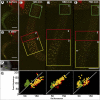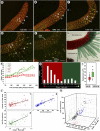Color recovery after photoconversion of H2B::mEosFP allows detection of increased nuclear DNA content in developing plant cells
- PMID: 22108524
- PMCID: PMC3252088
- DOI: 10.1104/pp.111.187062
Color recovery after photoconversion of H2B::mEosFP allows detection of increased nuclear DNA content in developing plant cells
Abstract
Many higher plants are polysomatic whereby different cells possess variable amounts of nuclear DNA. The conditional triggering of endocycles results in higher nuclear DNA content (C value) that in some cases has been correlated to increased cell size. While numerous multicolored fluorescent protein (FP) probes have revealed the general behavior of the nucleus and intranuclear components, direct visualization and estimation of changes in nuclear-DNA content in live cells during their development has not been possible. Recently, monomeric Eos fluorescent protein (mEosFP) has emerged as a useful photoconvertible protein whose color changes irreversibly from a green to a red fluorescent form upon exposure to violet-blue light. The stability and irreversibility of red fluorescent mEosFP suggests that detection of green color recovery would be possible as fresh mEosFP is produced after photoconversion. Thus a ratiometric evaluation of the red and green forms of mEosFP following photoconversion could be used to estimate production of a core histone such as H2B during its concomitant synthesis with DNA in the synthesis phase of the cell cycle. Here we present proof of concept observations on transgenic tobacco (Nicotiana tabacum) Bright Yellow 2 cells and Arabidopsis (Arabidopsis thaliana) plants stably expressing H2B::mEosFP. In Arabidopsis seedlings an increase in green fluorescence is observed specifically in cells known to undergo endoreduplication. The detection of changes in nuclear DNA content by correlating color recovery of H2B::mEosFP after photoconversion is a novel approach involving a single FP. The method has potential for facilitating detailed investigations on conditions that favor increased cell size and the development of polysomaty in plants.
Figures




Similar articles
-
mEosFP-based green-to-red photoconvertible subcellular probes for plants.Plant Physiol. 2010 Dec;154(4):1573-87. doi: 10.1104/pp.110.165431. Epub 2010 Oct 12. Plant Physiol. 2010. PMID: 20940350 Free PMC article.
-
Green-to-red photoconvertible mEosFP-aided live imaging in plants.Methods Enzymol. 2012;504:163-81. doi: 10.1016/B978-0-12-391857-4.00008-2. Methods Enzymol. 2012. PMID: 22264534
-
Maize histone H2B-mCherry: a new fluorescent chromatin marker for somatic and meiotic chromosome research.DNA Cell Biol. 2012 Jun;31(6):925-38. doi: 10.1089/dna.2011.1514. Epub 2012 Jun 4. DNA Cell Biol. 2012. PMID: 22662764 Free PMC article.
-
Green-to-red photoconvertible fluorescent proteins: tracking cell and protein dynamics on standard wide-field mercury arc-based microscopes.BMC Cell Biol. 2010 Feb 22;11:15. doi: 10.1186/1471-2121-11-15. BMC Cell Biol. 2010. PMID: 20175925 Free PMC article.
-
Photo-convertible fluorescent proteins as tools for fresh insights on subcellular interactions in plants.J Microsc. 2016 Aug;263(2):148-57. doi: 10.1111/jmi.12383. Epub 2016 Jan 28. J Microsc. 2016. PMID: 26820914 Review.
Cited by
-
Differential coloring reveals that plastids do not form networks for exchanging macromolecules.Plant Cell. 2012 Apr;24(4):1465-77. doi: 10.1105/tpc.111.095398. Epub 2012 Apr 3. Plant Cell. 2012. PMID: 22474180 Free PMC article.
-
Nuclear architecture and dynamics: territories, nuclear bodies, and nucleocytoplasmic trafficking.Plant Physiol. 2012 Jan;158(1):23-5. doi: 10.1104/pp.111.900426. Plant Physiol. 2012. PMID: 22213248 Free PMC article. Review. No abstract available.
-
Phototransformable fluorescent proteins: which one for which application?Histochem Cell Biol. 2014 Jul;142(1):19-41. doi: 10.1007/s00418-014-1190-5. Epub 2014 Feb 13. Histochem Cell Biol. 2014. PMID: 24522394 Review.
-
Cytomixis in plants: facts and doubts.Protoplasma. 2018 May;255(3):719-731. doi: 10.1007/s00709-017-1188-7. Epub 2017 Dec 1. Protoplasma. 2018. PMID: 29192339 Review.
-
O-glycosylation of the extracellular domain of pollen class I formins modulates their plasma membrane mobility.J Exp Bot. 2022 Jun 24;73(12):3929-3945. doi: 10.1093/jxb/erac131. J Exp Bot. 2022. PMID: 35383367 Free PMC article.
References
-
- Barow M. (2006) Endopolyploidy in seed plants. Bioessays 28: 271–281 - PubMed
-
- Berger CA. (1941) Reinvestigation of polysomaty in spinacia. Bot Gaz 102: 759–769
Publication types
MeSH terms
Substances
LinkOut - more resources
Full Text Sources
Molecular Biology Databases

